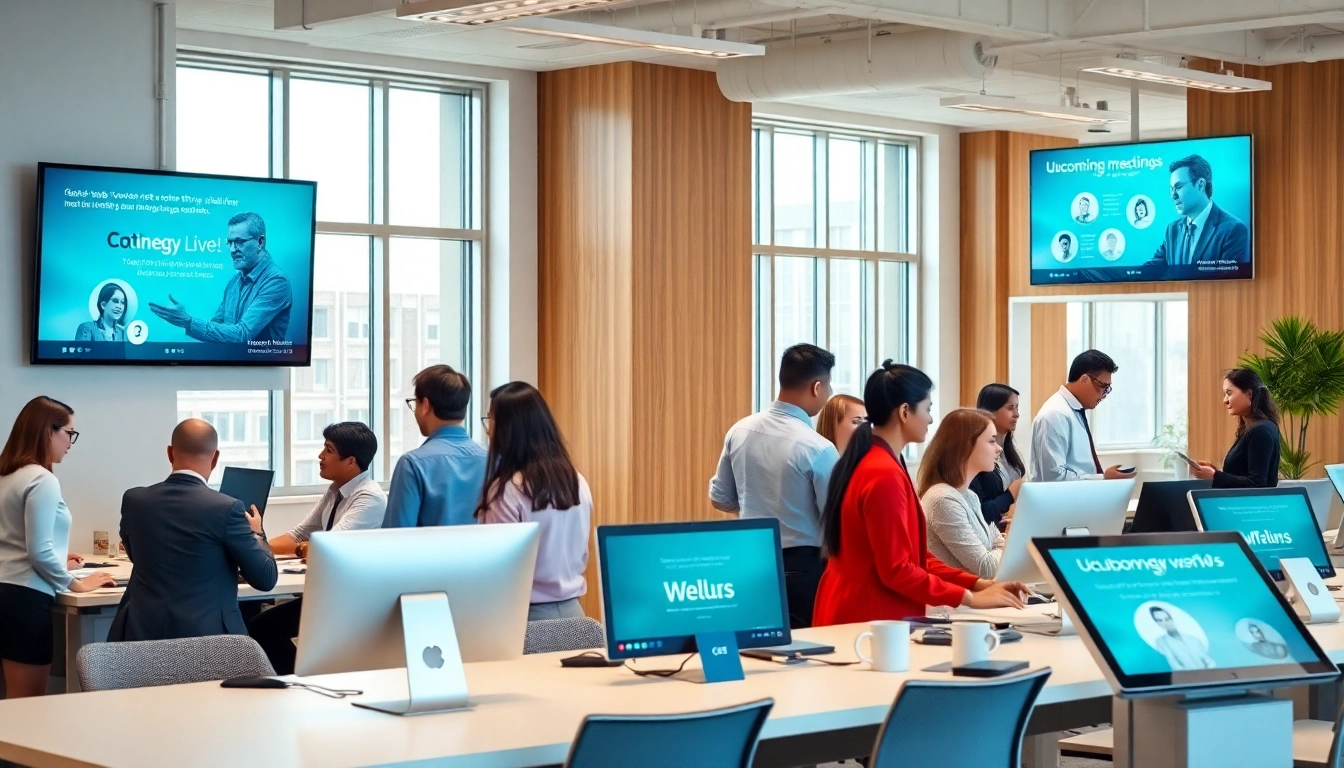
Understanding Digital Signage for Offices
What is Digital Signage for Offices?
Digital signage for offices refers to the dynamic display of multimedia content to communicate information and enhance the workplace environment. These digital displays can range from simple LED boards showing messages to sophisticated video walls presenting interactive content. The goal of digital signage in office settings is to streamline communication, engage employees, and create a vibrant, informative atmosphere that can respond to various needs, whether it’s for announcements, wayfinding, or promoting corporate branding.
Benefits of Digital Signage for Offices
Employing Digital signage for offices offers numerous benefits that contribute to overall efficiency and engagement:
- Enhanced Communication: Digital signage allows for real-time updates, ensuring that employees receive important news and information promptly.
- Cost-Effectiveness: Compared to traditional print materials, updating digital content is far less expensive and time-consuming.
- Improved Employee Engagement: Dynamic content can attract attention and keep employees informed about events, policies, and corporate news.
- Flexible Content Management: Digital signage networks enable easy changes to display content from any location, perfect for a remote or hybrid workforce.
- Brand Reinforcement: Digital displays can immerse employees in the company culture and values, enhancing brand loyalty.
Types of Digital Signage for Offices
Digital signage solutions vary widely, tailored to different objectives and environments:
- Informational Displays: These screens provide essential information, such as company announcements or procedural updates.
- Wayfinding Displays: Used within larger office complexes, these screens help employees and visitors navigate the premises.
- Event Promotion Displays: Digital signage can highlight upcoming events, meetings, and other corporate gatherings.
- Break Room Displays: Engaging content such as news feeds, social media integrations, and wellness information caters to employees during breaks.
- Interactive Digital Kiosks: Allowing users to seek information or engage with content create an interactive element to the workspace.
Implementing Digital Signage for Offices
Choosing the Right Hardware
Selecting the appropriate hardware is crucial to the success of digital signage. Options include:
- Display Screens: Choose sizes and types (LCD, LED, etc.) according to viewing distance and content requirements.
- Media Players: These devices connect to displays and are essential for content delivery. They can range from simple stick players to complex servers, depending on needs.
- Mounting Solutions: Proper mounting is essential for visibility and safety. Explore wall-mounted, ceiling-mounted, and freestanding solutions.
- Networking Equipment: Ensure reliable internet connectivity for remote management and updates, considering Wi-Fi or Ethernet options.
Software Solutions for Digital Signage for Offices
Choosing the right software is equally important for managing content effectively:
- Content Management Systems (CMS): A robust CMS is necessary to create, schedule, and distribute content efficiently. Look for user-friendly options that integrate with existing tools.
- Analytics Tools: Incorporate solutions that offer insights into engagement metrics, allowing continuous optimization of displayed content.
- Template Libraries: Access to pre-designed templates makes it easier to maintain visual consistency across various displays.
- Remote Management Features: Strong remote management capabilities enhance flexibility, allowing updates from anywhere.
Content Creation and Management
Content is the heart of any digital signage solution. Follow these steps to create compelling material:
- Define Goals: Understand the purpose of your signage. Whether branding, informing, or entertaining, clear objectives help shape content direction.
- Know Your Audience: Tailor messaging based on the demographic of your viewers, considering their preferences and needs.
- Engagement Strategies: Employ different formats (videos, infographics, social media feeds) to keep content fresh and interesting.
- Regular Updates: Schedule content updates frequently to maintain relevance and keep the audience engaged.
Best Practices for Digital Signage for Offices
Effective Messaging Strategies
Crafting messages that resonate can amplify the impact of digital signage:
- Clarity: Use straightforward language and large fonts to ensure readability from a distance.
- Brevity: Keep messages concise; attention spans can be limited in fast-paced environments.
- Call-to-Action: Use compelling CTAs to encourage specific employee actions, whether attending meetings or participating in events.
Design Principles for Impactful Displays
Good design is key to catching attention and retaining viewer interest:
- Visual Hierarchy: Organize content so that the most important information stands out. Utilize size, color, and placement strategically.
- Color Psychology: Employ colors that align with the office brand while also considering their psychological impact on viewers.
- Consistency: Maintain a uniform style across different digital signage applications for brand cohesion.
Measuring Engagement and Effectiveness
Regularly measuring the success of digital signage initiatives is essential for continuous improvement:
- Feedback Mechanisms: Implement methods for viewers to offer feedback, such as QR codes linking to surveys.
- Analytics Tracking: Use software analytics to assess viewer engagement rates and what type of content resonates most with employees.
- Adjustments Based on Insights: Refine content strategy based on the data collected, experimenting with different types of displays.
Common Challenges in Digital Signage for Offices
Technical Issues and Maintenance
Technical difficulties can hinder the effectiveness of digital signage. Here are ways to mitigate these issues:
- Regular Maintenance: Schedule routine check-ups on hardware and software to prevent unexpected failures.
- Redundancy Systems: Implement backup solutions to avoid total outages, ensuring continuity of information display.
Content Relevance and Freshness
Keeping content up-to-date requires diligent management:
- Scheduling Content Updates: Automate content scheduling to ensure messages remain current without missing opportunities to inform or engage.
- Engage Content Creators: Develop a team dedicated to refreshing content regularly to reflect changes in company policies, events, or culture.
Employee Adoption and Engagement
Fostering a culture of acceptance is vital for a successful digital signage program:
- Involve Employees: Seek input from employees during the content creation phase to create resonant and relevant material.
- Training Sessions: Educate employees about the benefits and functionalities of digital signage, involving them as active participants in the communication process.
Future Trends in Digital Signage for Offices
Integration with Emerging Technologies
The landscape of digital signage is evolving significantly due to technological advancements:
- Artificial Intelligence: AI can help analyze data to customize content based on viewer preferences and behaviors, enhancing relevance.
- Augmented Reality (AR): AR can offer interactive experiences, merging real and digital environments for enriched information dissemination.
Personalization and Dynamic Content
Tailoring content to specific users leads to greater engagement:
- User Profiles: Generate user profiles to deliver targeted messages based on demographics, preferences, or observed behaviors.
- Responsive Content: Use real-time data inputs to create dynamic content that changes based on current context or situations within the office.
Case Studies of Successful Implementations
Examining successful digital signage installations can offer valuable insights:
- Scenario Planning: Analyze case studies that showcase diverse strategies and implementations across various industries to gather practical knowledge.
- Lessons Learned: Take note of challenges faced and solutions found to refine your own digital signage strategy.






